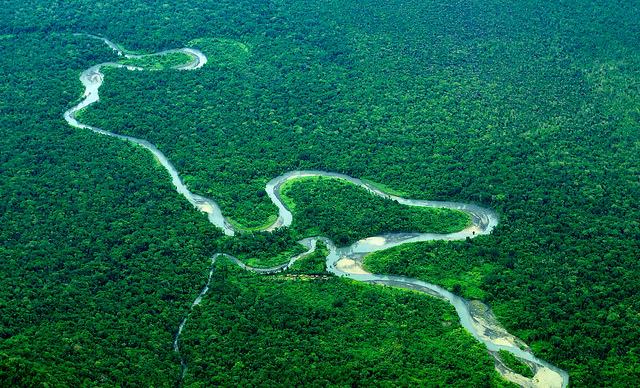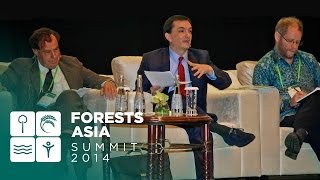JAKARTA, Indonesia — The necessary public and private investment to finance a “green economy” in Southeast Asia has so far been slow to arrive, experts said at a recent regional conference, urging a range of different approaches to help accelerate it.
Mobilizing financial resources to stimulate investments in smallholder agriculture and sustainable land use — ranging from REDD+ activities to a forest carbon market, among others — could help to slow drivers of deforestation. A financing gap has emerged, though, attributed by some to a lack of political will.
It was against this background that speakers from the private, public and development sectors met in a discussion forum at the recent Forests Asia Summit in Jakarta to examine innovative approaches to financing for inclusive green returns. The forum sought to address how public finance can leverage larger private-sector investments in sustainable landscapes, how smaller enterprises are best encouraged to sustainably use landscape resources, and how to remove perverse incentives such as fossil-fuel subsidies.
Panelists said almost as much about what shouldn’t be done.
Thomas Heller of the Climate Policy Initiative was quick to acknowledge the importance of the global debate about the green economy, but was equally quick to dismiss the debate’s achievements. “When you talk about the cost of system disruption, of actually changing the way we do agriculture,” he said, “then actually very little has happened.”
“The incentives for change at scale are not going to come from policies and international transfers. They’re going to come from the real economy — that is, the way we produce food and the way we produce fuel.”
Heller’s vision of a successful real economy includes vastly more efficient uses of resources; productivity gains derived from better science and information technology; an integrated array of ecosystem services derived from adopting a landscapes approach to managing natural capital; and service and product delivery via the use of a vastly more experienced private sector working in cooperation with public agencies.
Panelist Lou Munden, co-founder of the Munden Project, an environmental consulting firm, got to the core of the landscapes debate.
“How do you stimulate investment in smallholders on landscapes for green returns?” he said. If he had all the money and inclination in the world, Munden said, nothing would currently convince him to invest in sustainable landscape management. “The reason is, you lack evidence it works and you lack the financing schemes to pour my capital into in an effective and credible way.”
Munden emphasized the need to focus on processes in forestry and agriculture that result in “tangible, saleable products — in things that people will buy because they intend to use them. Those processes are capable of generating the types of cash flows we need to be interested in.”
Loans for sustainable agriculture, he continued, must contain three unique elements: longer repayment periods, lower interest rates and repayment schedules driven by nature, not bottom lines — none of which, in a standalone project, is typically acceptable to a bank. “But if you take many diverse loans like this across a number of different countries and aggregate them together intelligently,” Munden posited, “that is a real value proposition” that could interest banks.
This is not going to work by threatening people — ‘If you don’t do X, we’re not buying your products.’ It’s simply not an effective way of dealing with incentives in general.
A different approach to the challenge came from Yalmaz Siddiqui, a Senior Director with Office Depot, a US-based office-supply retailer. According to Siddiqui, Office Depot buys around 1 billion tons of paper products a year and can use this buying power to exert environmental good. He said Office Depot’s presence at the Forests Asia Summit was because “as a major buyer of forest products, … it is time to use our contracts in a positive way … to say to supply regions and companies that as environmental and sustainable performance improves, so you gain access to very significant contracts.”
Panelist Morris Vohner, a director with the Gold Standard Foundation, described how the foundation has certified around 1,000 projects as meeting its best-practice rules — rules that include requisite consultations with local stakeholders, continual reductions of greenhouse gas emissions, and improvements to the environment and people’s lives. Certified projects receive credits that are purchased by governments, business, impact investors and individuals. Vohner said the Foundation has so far issued $100 million in carbon credits, with much of this money going back in to sustainable landscape management.
The money to kickstart a global “green economy” is in no short supply, participants at the conference were told. How to unlock it — and how to spend it — were at the center of discussions throughout the Summit.
Heller said one thing is for sure: A green economy must be fostered through positive incentives.
“This is not going to work by threatening people — ‘If you don’t do X, we’re not buying your products.’ It’s simply not an effective way of dealing with incentives in general.”
We want you to share Forests News content, which is licensed under Creative Commons Attribution-NonCommercial-ShareAlike 4.0 International (CC BY-NC-SA 4.0). This means you are free to redistribute our material for non-commercial purposes. All we ask is that you give Forests News appropriate credit and link to the original Forests News content, indicate if changes were made, and distribute your contributions under the same Creative Commons license. You must notify Forests News if you repost, reprint or reuse our materials by contacting forestsnews@cifor-icraf.org.

